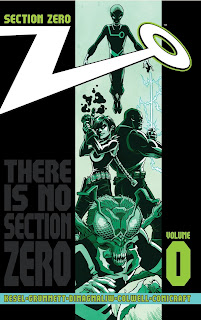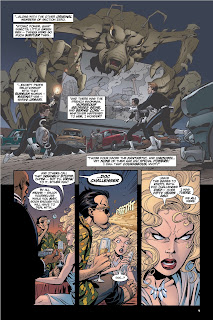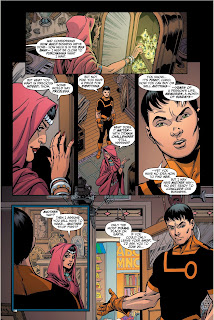There is no Section Zero.
That’s the tag line for the comic book series from writer/inker Karl Kesel and penciler Tom Grummett. The book tells the story of a team of United Nations operatives tasked with investigating the weird and unexplained. It’s kind of like the X-Files, if the X-Files had been created by Jack Kirby along the lines of Challengers of the Unknown and Fantastic Four. It’s a big, bold, beautiful comic full of intriguing characters, larger than life monsters, high adventure, drama, mystery, and humor. And, for too long, it felt like “There is no Section Zero” was sadly more than an apt tag line.
The series premiered in 2000 from Image Comics, as part of the Gorilla Comics line created by Mark Waid, Kurt Busiek, Karl Kesel, Stuart Immonen, Barry Kitson, and others. Unfortunately, for a number of reasons, Kesel and Grummett had to suspend the comic after only a handful of issues. In 2012, they attempted to bring it back as a web comic, but that lasted less than 10 pages. I was around for both of those incarnations. As a fan of both creators, as well as the Jack Kirby comics that influenced them, I was super-excited to read a book that played to my interests as much as it did theirs. And, both times, I was super disappointed to see the story go unfinished.
In 2017, Kesel and Grummett launched a Kickstarter campaign to finally complete the story and publish it as a single volume. I eagerly jumped on board. The campaign was successful, and in 2018, I finally held in my hands the first complete Section Zero story, with promise of more to come.
Despite the clear influences of the Kirby comics I’ve already mentioned, Section Zero is much more than just a reworking of the FF or Challengers of the Unknown in different costumes. As a series, it’s also a much broader idea than either of those series. For example, the prologue to this book features a trio of mysterious individuals discussing the whole history of Section Zero, and we see how the team has changed and evolved over the decades.
The earliest version, from the 50s or 60s, who faced “the fantastic and unknown,” perhaps more resembles the original Challengers of the Unknown, in that it’s a group of people with no special powers. The 70s iteration of the team incorporates weirder, powered beings, and the art on that flashback looks maybe a little less Jack Kirby, more Neal Adams or Frank Brunner. The 80s version of the team isn’t even seen fighting a giant monster; instead, Kesel and Grummett show them capturing a more human-sized Jersey Devil.
When the story properly opens in the year 2000, we meet the current team through the eyes of Thom Talesi, a young kid who can turn into a giant insect, but only for one day. The team, comprised of genius scientist Doctor Tina Challenger, musician turned monster hunter Sam Wildman, and the alien Tesla seek out Thom and recruit him to Section Zero. Almost immediately, they had to Australia to investigate reports of some unusual creature that is killing cattle.
 |
| Thom meets the Section Zero team |
 |
| Arriving at Section Zero HQ for the first time |
While the team does uncover the creature doing the killing, they also find the mummified body of Sargasso, a Creature From the Black Lagoon-esque monster who has worked with Section Zero in the past. However, before we can learn the truth connecting all these events, Doctor Challenger disappears into a mysterious portal resembling a ring of fire. As Sam and the others—including Sargasso, who has seen this ring of fire before—investigate, we meet some other weird residents of this comics’ world, including a race of subterranean dwellers worshipping albino alligators who live in the sewers of New York, a team of immortal soldiers, and Curio, a mysterious woman who runs a store full of mystical artifacts, and who can offer up information about the supernatural, but always for a price.
While the first half of the story is a fairly straightforward tale of the remaining members of Section Zero trying to recover their missing teammate, the storytelling takes an interesting turn beginning with Chapter Four, the first new chapter produced specifically for this volume. According to Kesel, they always intended to tell the story of Section Zero in real time. So the parts of the story created in 2000 are set in the year 2000. The new chapters were created in 2017 and 2018, and are set 18 years after the disappearance of Doctor Challenger. This is where the storytelling really diverges from the traditional action-adventure comic formula, and becomes all the more interesting for it.
I feel like most comics would tell the story of Doctor Challenger going missing, and follow that story in a linear fashion through to the end, possibly with someone uttering some kind of “we’re not going to rest until we find her!” vow at some point. However, while Tina’s disappearance and the events connected to finding her are very much the focus of this story, Kesel and Grummett make it very clear that this isn’t all that the team has been doing over the course of those 18 years. We see the team lineup change and evolve, and see snippets of them on other missions. This not only raises the stakes of the search for Tina Challenger, because it isn’t something that can be resolved quickly or easily, but it also opens up the series for a lot of potential. This book covers the story of what happened to Doctor Challenger, but it also drops so many hints of so many other stories and adventures, both past and future.
 |
| Flashback to Tina and Sam's past. Which, of course, includes a giant monster |
Like Ron Randall’s Trekker, I feel like the concept that Kesel and Grummett have set up here allows them to tell almost any kind of story that they want. Because of the long history they have established for Section Zero, we aren’t confined to stories about the particular teams we see here. (And we do see six different teams in six different time periods over the course of this story.)
 |
| Alligators in the sewers |
To greater or lesser degrees, we see giant mutated insects, mythological creatures like the Jersey Devil and giant trolls, mysterious hidden lands with dinosaurs and unicorns and lost civilizations and jungle princesses, people with mystical powers and alien beings with hidden pasts. We hop around the globe, from Southeast Asia to Australia to the sewers of New York to—of all places—the Mall of America. And at the heart of it, once you get past the monsters and the action, we get a story of genuine human love that grounds it all and makes it relatable.
 |
| The 2018 Section Zero team |
Of course, we also get lots of cool action and adventure and giant monsters and weirdness. While Kesel and Grummett aren’t aping Kirby in these pages, they are clearly influenced by his style, bringing a great deal of enthusiasm and passion and larger-than-life storytelling to their work. While Grummett may not wear his Kirby influences on his sleeve the same way other artists, like Steve Rude, might, you can feel the Kirby genes in his art. Like the best artists, Grummett (with inks by Kesel) takes those influences and builds upon them. This story brings in so many different elements, but because of the skills of its creators, manages to make them all work together and fit together seamlessly into one whole.
I’ve seen fans online complaining that the problem with comics today is not enough respect for the past, resulting in comics series today, like the Fantastic Four, that are drastically different from when they premiered 50 or 60 or 70 or more years ago. I disagree. I say the problem with comics today is fans slavishly devoting themselves to characters that were created 50 or 60 or 70 or more years ago and expecting them to remain unchanged, instead of looking for the sorts of comics they are going to enjoy, regardless of whether they have a familiar logo on the cover.
 |
| The 2002 version of the team |
Put another way, if your problem with the Fantastic Four today is that you feel that it is no longer feels like the comic Jack Kirby and Stan Lee created almost 60 years ago, maybe your best option is to find a comic that does recapture that spirit. A comic like Section Zero, for example. A comic that, as long as it is completely owned by its creators, will remain consistent with their vision and tone for the series. It won’t change at the whim of corporate owners or changing creative teams. We live in a time when any fan should be able to find the sort of comic that they will love, but sometimes you need to actually look around to find it. And when you find it, you need to support it. (Section Zero can be ordered here.)
(Of course, if what you only want is actual Fantastic Four stories in the style of Jack Kirby and Stan lee, then maybe just quit whining and read some reprints. Either way, maybe just stop whining.)
I’m glad that we’ve got this volume of Section Zero, and look forward to the next book, which is already in the works. Kesel has also developed another new series, Impossible Jones, which he has described as a cross between Harley Quinn and Jack Cole’s Plastic Man, by way of Will Eisner. He attempted to Kickstart a single-issue launch for Impossible Jones, but for a number of reasons, he canceled it. He has said that he plans to try to launch it as a graphic novel next year, and I hope that finds more success. Again, I see the fans insisting that there aren’t enough “fun” comics any more. Well, here is one that is exactly what they are asking for; time to put their money where their mouths are.
In other news, the latest Trekker Kickstarter has just a few days left to go, and just over $1000 to reach its next stretch goal. I’ve written about Trekker here and here; please check it out, and consider supporting this latest book.
Also, after I wrote about The Bozz Chronicles, I learned that there are plans in the works to bring it back, written and drawn by original creators David Michelinie and Bret Blevins. Nothing could make me happier than to see that happen. I will keep you posted once more news becomes available.
Finally, this week’s Pop! of the Week is a Disney Parks Exclusive of Redd, the latest addition to Pirates of the Caribbean. You may notice a striking resemblance to the redhead being auctioned off in a much-beloved scene from the ride. Recently, Disney retooled the scene so that it isn’t an auction of women, and the redhead is now a pirate captain. There has been a lot of hue and cry online from the folks who really feel the need for more representation of human trafficking in the Disney Parks, but I’m okay with the changes.
And that’s it for this week. See you next week, if I can figure out what I want to write about.















No comments:
Post a Comment